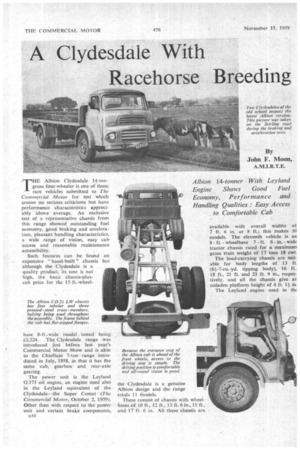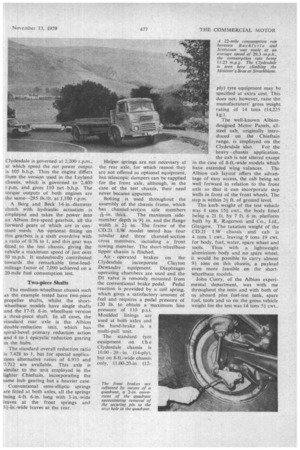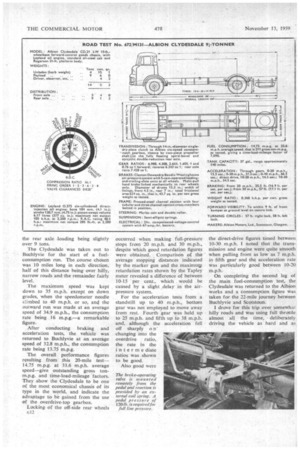A Clydesdale With Racehorse Breeding
Page 112

Page 113

Page 114

Page 115

If you've noticed an error in this article please click here to report it so we can fix it.
Albion 14-tonner With Leyland Engine Shows Good Fuel Economy, Performance and Handling Qualities. Easy Access
to Comfortable Cab
THE Albion Clydesdale 14-tongross four-wheeler is one of those rare vehicles submitted to The Commercial Motor for test which arouse no serious criticisms but have performance characteristics appreciably above average. An exclusive test of a representative chassis from this range showed outstanding fuel economy, good braking and accelerafion, pleasant handling characteristics, a wide range of vision, easy cab access and reasonable maintenance accessibility.
Such features can be found on expensive " hand-built " chassis but although the Clydesdale is a quality product, its cost is not high, the basic chassis-pluscab price for the 15-ft.-wheel base 8-ft.-wide model tested being £2,224. The Clydesdale range was introduced just before last year's Commercial Motor Show and is akin to the Chieftain 7-ton range introduced in July, 1958, in that it has the same cab, gearbox and rear-axle gearing.
The power unit is the Leyland 0.375 oil engine, an engine used also in the Leyland equivalent of the Clydesdale—the Super Comet (The Commercial Motor, October 2, 1959). Other than with respect to the power unit and certain brake components,
available with overall widths ot 7 ft. 6 in. pr 8 ft.; this makes 10 models. The eleventh vehicle is an 8ft. wheelbase 7 ft. 6in.wide tractor chassis rated for a maximum gross train weight of 17 tons 18 cwt.
The load-carrying chassis are suitable for body lengths of 13 ft. (64-7-cu.-yd. tipping body), 16 ft. 18 ft., 21 ft. and 23 ft. 9 in., respectively, and all the chassis give ar unladen platform height of 4 ft. 14in The Leyland engine used in du Clydesdale is governed at 2,200 r.p.m., at which speed the net power output is 105 b.h.p. Thus the engine differs from the version used in the Leyland chassis, which is governed to• 2,400 r.p.m. and gives 110 net _b.h.p. The torque outputs of both engines are the same----285 lb./ft. at 1,100 r.p.m.
A Borg and Beck 14-in.-diameter clutch with hydraulic actuation •is employed and takes the power into an Albion five-speed gearbox, all the forward gears of which are in constant mesh. An optional fitting on this gearbox is a sixth overdrive with a ratio of 0.76 to 1, and this gear was fitted to the test chassis, giving the vehicle a maximum speed of just over 50 m.p.h. It undoubtedly contributed towards the remarkable time-loadmileage factor of 7,090 achieved on a 20-mile fuel consumption test.
Two-piece Shafts
The medium-wheelbase chassis such as the example tested have two-piece propeller shafts, whilst the shortwheelbase models have single shafts and the 17-ft. 6-in, wheelbase version a three-piece shaft. In all cases, the standard rear axle is the Albion double-reduction unit, which has spiral-bevel primary reduction action and 4 to 1 epicyclic reduction gearing in the hubs.
The standard overall reduction ratio is 7.428 to 1, but for special applications alternative ratios of 6.933 and 7.712 are available. This axle is similar to the unit employed in the lighter Chieftain, incorporating the same hub gearing but a heavier case.
Conventional semi-elliptic springs are fitted at both axles, all the springs being 4-ft. 6-in, long with 3-in.-wide leaves at the front springs and 3,1-in.-wide leaves at the rear.
Helper springs are not necessary at the rear axle, for which reason they are not offered as optional equipment, but telescopic dampers can be supplied for the front axle, although, in the case of the test chassis, their need never became apparent.
Bolting is used throughout the assembly of the chassis frame, which has channel-section side members
thick. The maximum sidemember depth is 94 in. and the flange width is 21 in. The frame of the CD.21 'LW model tested has four tubular and three channel-section cross members, including a front towing member. The short-wheelbase tipper chassis is flitched.
Air operated brakes on the Clydesdale incorporate Clayton Dewandre equipment. Diaphragm operating chambers are used and the D1 valve is remotely mounted from the conventional brake pedal. Pedal reaction is provided by a coil spring, which gives a satisfactory ,amount of feel and requires a pedal pressure of 120 lb. to obtain a 'maximum line pressure of 110 psi. Moulded linings are used at both axles and the hand-brake is a multi-pull unit.
The standard tyre equipment on t h e Clydesdale chassis is 10.00 20 in, (14-ply). but on 8-ft.-wide chassis only, 11.00-20-in. (12
ply) tyre equipment may be specified at extra cost. This does not, however, raise the manufacturers' gross weight rating of 14 tons (14,225 kg.): The well-known Albiondesigned Motor Panels, allsteel cab, originally introduced on the Chieftain range, is employed on the
Clydesdale also. For the heavy -chassis application, the cab is not altered except in the case of 8-ft.-wide models which have extended wing valances. The Albion cab layout offers the advantage of easy access, the cab being set well forward in relation to the front axle so that it can incorporate step wells in front of the-front wheels. The step is within 21 ft. of ground level.
The kerb weight of the test vehicle was 4 tons 15* cwt., the body fitted being a 21 ft. by 7 ft. 6 in. platform built by R. Rogerson and Co., Ltd., Glasgow. The taxation weight of the CD.21 LW chassis and cab is 4 tons 1 cwt., leaving. 9 tons 19 cwt. for body, fuel, water, spare wheel and tools. Thus with a lightweight aluminium body and no spare wheel, it would be possible to carry almost 91 tons on this chassis, a payload even more feasible on the shortwheelbase. models.
John Curry, of the Albion experimental department, was with me throughout the tests and with both of us aboard plus fuel-test tank, spare fuel, tools and so on the gross vehicle weight for the test was 14 tons 54 cwt., the rear axle -loading being slightly over 9 tons.
The Clydesdale was taken out to Buchlyvie for the start of a fuelconsumption run. The course chosen was 10 miles long in each direction, half of this distance being over hilly, narrow roads and the remainder fairly level.
The maximum speed was kept down to 35 m.p.h. except on down grades, when the speedometer needle climbed to 40 m.p.h. or so, and the outward run was made at an average speed of 34.9 m.p.h., the consumption rate being 16 m.p.g.—a remarkable figure.
After conducting braking and acceleration tests, the vehicle was returned to Buchlyvie at an average speed of 32.8 m.p.h., the consumption rate being 13.75 m.p.g.
The overall performance figures resulting from this 20-mile test-.14.75 m.p.g. at 33.6 m.p.h. average speed—give outstanding gross tonm.p.g. and time-load-mileage 'factors. They .show the Clydesdale to be one of the most economical chassis of its type in the world, and indicate the advantage to be gained from the use of the overdrive-top gearbox.
Locking of the off-side rear wheels cl/ occurred when making full-pressure stops from 20 m.p.h. and 30 m.p.h., despite which good retardation figures were obtained. Comparison of the average stopping distances indicated by the marker gun and the maximuilt retardation rates shown by the Tapley meter revealed a difference of between 10-15 per cent., which would be caused by a slight delay in the airpressure system.
For the acceleration tests from a standstill up to 40 m.p.h., bottom • gear was not employed to move away from rest. Fourth 'gear was held up to 25 m.p.h. and fifth up to 38 m.p.h, and, although the acceleration fell off sharply on changing into the overdrive ratio, the rate in the intermediate ratios was shown to be good.
Also good were the direct-drive figures timed between 10-30 m.p.h. I noted that the transmission and engine were quite smooth when pulling from as low as 7 m.p.h. in fifth gear and the acceleration rate was particularly good between 10-20 m.p.h.
On completing the second leg of the main fuel-consumption test, the Clydesdale was returned to the Albion works and a consumption figure was taken for the 22-mile journey between Buchlyvie and Scolstoun.
I drove for this trip over somewhat hilly roads and was using full throttle almost all the time, • deliberately driving the vehicle as hard and as
fast as it would go to see what sort of an average speed could be set up. under difficult conditions, and what effect such a driving technique would 'lave on the fuel-consumption rate.
The journey was completed at the ;omewhat remarkable average speed af 29.3 m.p.h.—remarkable because he last five or six miles were through iensely populated areas and the road ncluded such climbs as the Minister's Brae at Strathblane, a hill requiring he use of second gear for several ninutes.
Measurement of the fuel used ;howed the consumption rate to be [1.25 m.p.g., a result which still gives gross-ton-m.p.g. figure and a timeoad-mileage figure of 161 and I,737 respectively. Undoubtedly the Dlyclesdale is a glutton for punishment ind reacts kindly to the harshest of reatment—a workhorse in the old radition.
Hill-climbing tests were carried out m both sides of the Clyde. A short ncline of 1 in 5 severity—Murrayfield )rive---was chosen for the stop-start est. The multi-pull hand brake held he vehicle safely both when facing ip the incline and down it, and entirely atisfactory bottom-gear and reverse
e-starts were made. Slight hazing /as observed at the exhaust outlet luring these re-starts.
1.3-mile Climb The Renfrew ferry was made use ,f when crossing into Paisley, the harge for a vehicle of this size being s. 6d., and the Clydesdale was taken irough Paisley out to Gleniffer Iraes, a 1.3-mile-long climb with an verage severity of 1 in 13 and steep !ctions of up to 1 in 8.
The ascent was made in an ambient !mperature of 59' F., and before ommencing the climb, the radiator aolant and rear-axle oil temperatures 'ere recorded, these being 162° F. nd 112° F. respectively.
The test lasted 7 min. 50 sec., showig unusual agility for a vehicle of is weight on such a hill, and second ear was used on three occasions m* a total time of 2 min. 25 sec., kird gear sufficing for most of the st of the climb. The minimum speed hen using second gear was 7 m.p.h. Checks at the top of the hill showed ie engine-coolant temperature to aye risen by only 15° F., whilst the mperature of the rear-axle oil had sea by only 6° F. These small rises dicate the efficiency of the engine mling system and one of the advan
ges of a double-reduction axle.
To test for brake-fade resistance, e Clydesdale was coasted down the 11 in neutral, using the foot brake restrict the maximum speed to 20 m.p.h. Unfortunately, because of the uneven road surface, I found it difficult to keep my right foot still on the brake pedal and the resulting. " dither " caused the air reservoir to exhaust at a faster rate than the compressor (which was rotating slowly because the engine was idling) could recharge it.
Thus when I made a crash stop at the end of this test, the maximum available air pressure was only 50 p.s.i., with the result that the Tapley meter reading was 30 per cent., a drop of 37.5 per cent, compared with the figures obtained on the previous day under normal conditions.
However, by running the engine and driving farther along the road, I was able to make a second stop 11 min. later with full air pressure, and this produced a Tapley meter reading of 50 per cent. Thus it can safely be assumed that the reduction in braking efficiency evidenced by the first stop after the descent owed little to genuine brake fade, and under normal condi-, tions when descending a hill with a gear engaged, brake fade should not be experienced.
I thoroughly enjoyed driving the Clydesdale, it being a pleasant vehicle to ,handle. The gearbox is a delight to use and the engine gives, a lively performance, making it easy to keep up a high average speed under difficult road conditions.
I felt that the steering castor action was a little too strong, this being noticed mostly at low speeds, but nevertheless tending to make it hard work to take sharp corners quickly when travelling all out." I am given to understand that the castor angle is to be modified.
When driving at 50 m.p.h. and above, excessive propeller shaft vibration was apparent and this is another trouble Albion experimental engineers have in hand to cure. It may be effected by the use of a threepiece propeller shaft. The brakes have a good " feel " about them and may be relied upon to do their job properly under all conditions. A somewhat annoying characteristic was the tendency to " grunt " when braking in reverse.
The cab provides a high degree of driver and passenger comfort and the range of visibility is good. Ventilation is entirely adequate and excessive engine noise does not filter through the insulated cowl.. I cannot claim to be enamoured of the adjustment arrangement for the driving seat: this provides a wide range of adjustment but is rather difficult to actuate. The ride in the cab is entirely comfortable despite the absence of front axle suspension dampers.
Front-brake Adjustment
So far as maintenance is concerned, the Clydesdale for the most part follows its stable mate, the Leyland Super Comet, the maintenance of which was dealt with in the road test report published on October 2, 1959. The main differences lie in the method of front-brake adjustment and the position of the spare-wheel carrier.
The front brakes have an adjusting quadrant and the method of adjustment is to push this quadrant downwards and measure the distance travelled by the operating rod. When this movement becomes 2 in. the pin securing the brake-operating lever to the quadrant is removed and inserted in the next hole in the quadrant. • This arrangement does not give the same adjustment sensitivity as is provided by the worm-type adjusters used on the rear brakes, but the procedure is quite simple and the layout has the advantage that it is less complicated.
The spare-wheel carrier is mounted nearer the end of the frame than it is on the Super Comet. Thus, manhandling in and out of the carrier is simplified, although replacement of the wheel would be a two-man job.
































































































































































































































































